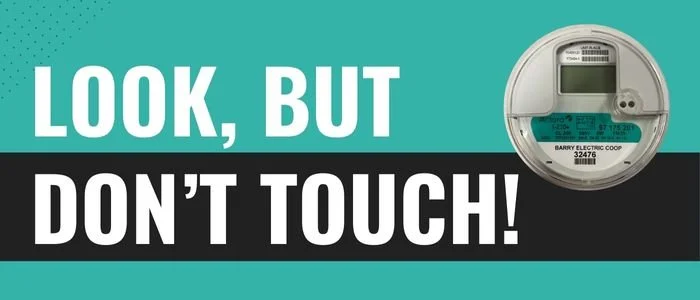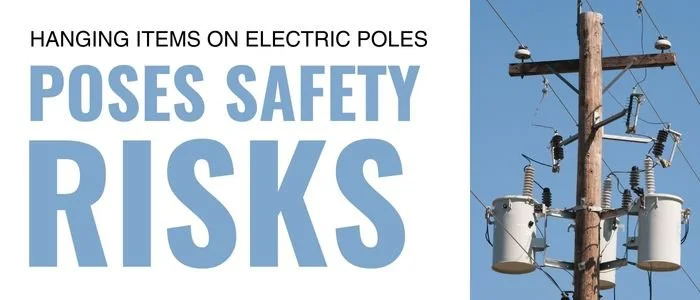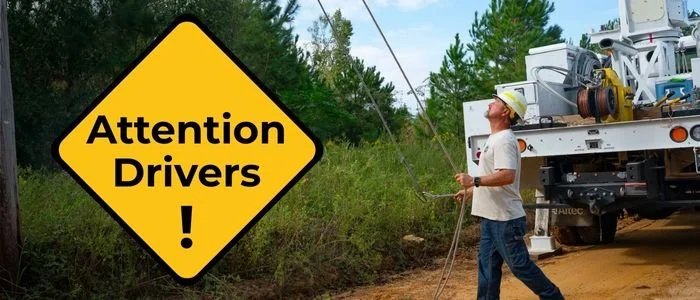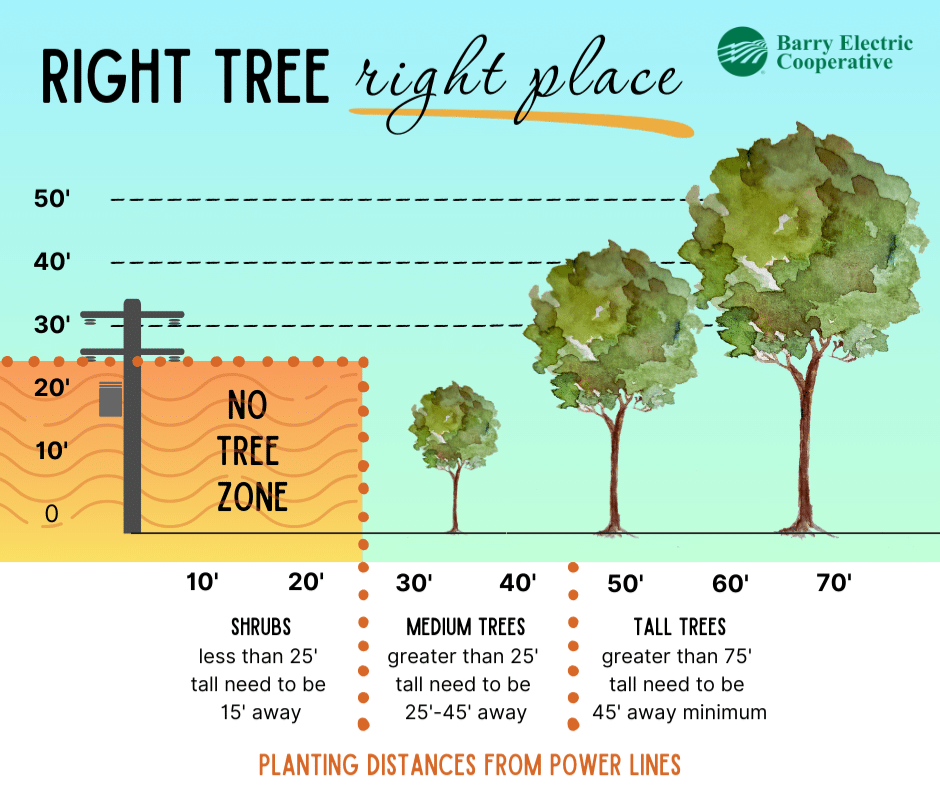Safe Extension Cord Use
-Use the shortest cord for your power needs to reduce resistance and overheating.
-Not all cords have surge protection.
-Avoid overloading: never daisy-chain multiple cords.
-For outdoor use, ensure the cord is rated for outdoor use.
-Avoid pinching under doors and windows to prevent overheating
Farmers: Stay Safe in the Field
-Keep at least 10 feet from power lines when using equipment.
-Check for nearby power lines before you lift or extend any tools.
-Ensure everyone on your farm knows the importance of staying clear of power lines.
-If you notice any downed lines or damaged poles, report them immediately to your electric company.
Look, But Don’t Touch!
Your electric meter is a necessary part of the system. While looking at it is encouraged, opening or tampering with it is not.
Attempting to adjust an electric meter poses a significant risk of fatal electric shock AND it is illegal. We encourage a hands-off approach to avoid both kinds of trouble.
Leave Tree Trimming to the Experts
-Tree trimming is best left to experts, especially when the trees are located near power lines.
-Wear safety glasses to protect your eyes from debris.
-Wear ear protection, slip-resistant shoes, chaps, and gloves when operating a chainsaw.
-Tie ladders to a secure structure and never go near power lines with a ladder or long-handled tool.
-Be aware of anyone on the ground when you are on a ladder or roof.
Still Keeping it Old-School?
While an old-school transfer switch, meter box, or breaker/fuse box may still do its job, it can’t match the safety features of modern equipment.
Ensure your safety by replacing any outdated equipment that doesn’t meet current safety standards. Consult a qualified electrician for a thorough inspection of your electrical wiring and fixtures.
Hanging Items on Electric Poles Poses Safety Risks
Attaching things to electric poles increases your risk of electric shock. It can also interfere with maintenance repairs and weaken the structural integrity of the pole over time.
Avoid attaching these items to poles:
· Christmas lights
· Thermometers
· Signs
· Birdhouses
· Pet leashes/chains
Accidents Happen
Do YOU know what to do if your car crashes into an electric pole? Knowing what to do could be the difference between life and death.
If a power line falls on your vehicle and there is NO FIRE: Your safest option is to stay inside your vehicle until help arrives. The vehicle acts as a path for the electrical current to reach the ground. You are safe inside the vehicle, but if you get out, you could be the new path of least resistance for the electricity to reach the ground, and you could be electrocuted.
If a power line falls on your vehicle and there IS A FIRE: To exit, jump out of the vehicle with both feet at the same time, making sure no part of your body or clothing is touching the ground and the vehicle simultaneously. Land with both feet together and bunny hop away from the vehicle. If you are unable to bunny hop safely, you can also shuffle your feet until you are as far away from the burning vehicle as possible. Bunny hopping and shuffling both reduce "step potential."
Step potential occurs when there is an electrical current in the ground. It ripples outward, much like the visual of a rock being thrown into water. The farther away the ripples, the less current flows through them. You want both of your feet to remain in the same level of current. Taking normal steps puts one foot in a different level of current, and invites electricity to flow through your body, which is what you want to avoid.
As a witness to a vehicle accident, most people's instinct is to help. If the accident involves a power line, always assume the line is LIVE. Do not go near the vehicle. You are in the same danger as the person inside the vehicle when it comes to step potential. Call 911 and make sure to tell the dispatcher about the electric lines that are involved; they will contact the proper utility company. Make sure no other bystanders get near the vehicle until utility crews have disconnected power.
If you have questions, please call us at 417-847-2131. Stay safe!
Attention Drivers
Please stay alert and reduce your speed when passing utility crews working along the roadside. Keep a safe distance and be respectful of their work. Your vigilance helps ensure the safety of everyone involved. Thank you for your cooperation!
Want to add some color and greenery to your yard? Go for it! You’re welcome to plant whatever you’d like — just keep in mind our right-of-way. We ask for 15 feet on both sides of our lines, totaling 30 feet. Be sure to consider how big your trees and shrubs will get at their mature height and width so they don’t grow into the power lines or block access. A little planning now means a beautiful (and safe) landscape later!
If you have any specific questions about planting near our lines, give us a call at 417-847-2131 and ask for Jeremy — he’s our Right-Of-Way Supervisor and a certified arborist, and he's always willing to help!
RV & Camping Safety
Average Draw of RV Appliances:
Air Conditioner- 15 amps
Electric Water Heater- 10 amps
Microwave- 10 amps
Refrigerator- 5 amps
Main System Differences:
30-amp
· 3-pronged plug, 120-volt hot wire, a neutral wire, and a ground wire
· Typically provides up to 3,600 watts
· Fewer outlets than 50-amp RVs
· Typically, a 30-amp RV has a single row of breakers
50-amp
· 4-pronged plug, two 120-volt hot wires, a neutral wire, and a ground wire
· Typically provides up to 12,000 watts
· More outlets than 30-amp RVs
· A 50-amp RV camper typically has a split breaker
Please visit https://membersfirst.coop/CampingSafety for more camping safety tips!











